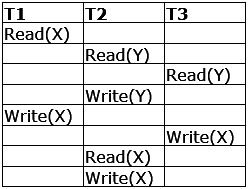GATE CS : Databases Champion Quiz 4
Attempt now to get your rank among 697 students!
Question 1
I. 2-phase locking
II. Time-stamp ordering
Question 2
Consider the following log sequence of two transactions on a bank account, with initial balance 12000, that transfer 2000 to a mortgage payment and then apply a 5% interest.
1) T1 start
2) T1 B old=1200 new=10000
3) T1 M old=0 new=2000
4) T1 commit
5) T2 start
6) T2 B old=10000 new=10500
7) T2 commit
Suppose the database system crashes just before log record 7 is written. When the system is restarted, which one statement is true of the recovery procedure?
Question 3

Which of the above schedules are conflict-serializable?
Question 4

Which of the following statements is correct?
Question 5
Question 6
Date_of_Birth →Age,
Age →Eligibility ,
Name → Roll_number,
Roll_number →Name,
Course_number → Course_name,
Course_number →Instructor,
(Roll_number, Course_number) →Grade
The relation (Roll_number, Name, Date_of_birth, Age) is
Question 7
Consider the following schedule for transactions T1, T2 and T3: 
Which one of the schedules below is the correct serialization of the above?
Question 8
Question 9


Consider these statements about Query1 and Query2.
1) Query1 will produce the same row set as Query2 for some but not all databases.
2) Both Query1 and Query2 are correct implementation of the specification
3) Query1 is a correct implementation of the specification but Query2 is not
4) Neither Query1 nor Query2 is a correct implementation of the specification
5) Assigning rank with a pure relational query takes less time than scanning in decreasing balance order assigning ranks using ODBC.
Which two of the above statements are correct?
Question 10
T1: r1(X); r1(Z); w1(X); w1(Z)
T2: r2(Y); r2(Z); w2(Z)
T3: r3(Y); r3(X); w3(Y)
S1:r1(X);r3(Y);r3(X);r2(Y);r2(Z);w3(Y);w2(Z);r1(Z);w1(X);w1(Z)
S2:r1(X);r3(Y);r2(Y);r3(X);r1(Z);r2(Z);w3(Y);w1(X);w2(Z);w1(Z)
Which one of the following statements about the schedules is TRUE?
- 697 attempts
- 4 upvotes
- 15 comments
Tags :
GATE & PSU CSDatabases
